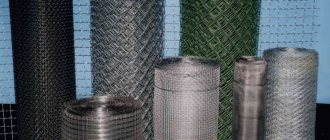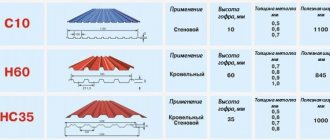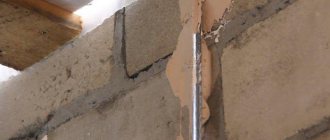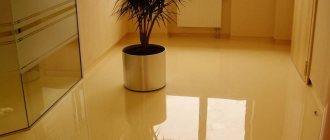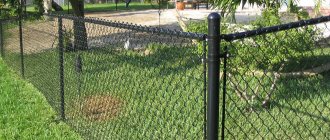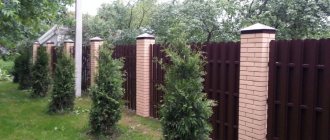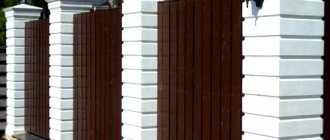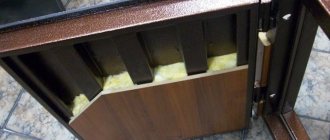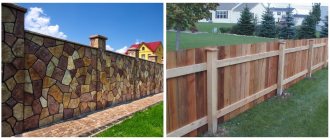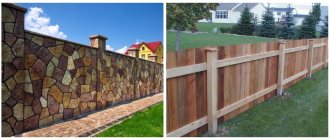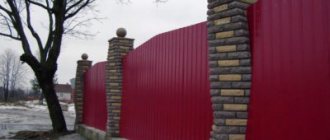Fence pipes are a universal base for enclosing structures. Thanks to the advantages and features, such supports will last a long time. The material of the supporting frame is important because the structure rests on it. Wooden poles last a maximum of 10-15 years, concrete is no less reliable than metal, but is difficult to install. Thus, metal pipes are a strong and solid frame for a fence onto which any material can be attached.
What do you prefer for supports?
MetalWood
Peculiarities
Intake pipes differ from products intended for laying water or gas pipelines. The supports are made of high strength steel and have a different cross-sectional diameter and wall thickness. Thin water pipes are only suitable for decorating sections.
Expert opinion
Vladimir Ulyanov
I have been involved in fences for over 10 years, answering questions and helping people cope with the installation task on their own.
Ask a question to an expert
Varieties of profiled metal products are standardized with a rectangular cross-section, and in rare cases - round posts. The latter are used for the construction of temporary fences, since they can simply be driven into the ground.
Round supports are installed without a foundation, so they need to be buried at least 1 m or 1.2 m into the ground.
Permanent fences are built on the basis of profile structures. They are distinguished by the presence of stiffening ribs, which increase reliability and strength.
Advantages of metal supports:
- ability to withstand high loads;
- can be painted and processed;
- the ability to install and dismantle any facing material: from wood to polycarbonate;
- repeated use, which affects the cost - you can buy used (used) rolled metal.
The main feature of intake pipes is the protective elements at the ends (plugs). The product is hollow inside, but with closed holes by welding. The likelihood of debris and water accumulation inside the profile is significantly reduced. The method increases the service life of the pipe. Hollow fence pipes are filled with pebbles to achieve a similar purpose and greater strength.
Useful What is better to install fence posts made of corrugated sheets: types, sizes, installation
Other nuances of installing tubular supports include climatic conditions and soil density. Simple driving into the ground is suitable for low or temporary fencing - the soil gets wet, dries out or freezes. As a result, the frame tilts, loses stability and collapses the structure.
The rectangular profile is poured with a cement foundation. The depth is less because the base is more firmly fixed.
The rigidity of the pillars increases if the wide side of the pipe is the front one.
Regarding round supports, this feature does not need to be taken into account - a light facing covering (for example, chain-link) will not create much wind resistance.
Installation of metal pipe supports
The pipes must first be welded on top or other plugs installed to prevent precipitation from entering. If you weld a cross of reinforcement onto the lower edge of the pipe, the stability of the support will increase.
Install corner posts, stretch the twine at a distance of 30 cm from the ground and along the top. Places for holes for posts under the corrugated fence are marked. The holes are made with a manual or electric drill to a depth of 1-1.5 m with a diameter of 30 cm. It is recommended to wrap the walls with roofing felt - this will prevent the earth from crumbling. This will also protect the supports from deformation when the soil settles: the soil will slide over the roofing felt.
Crushed stone or gravel is poured to the bottom - 20 cm, a pole is installed (it should not pierce the pillow, otherwise corrosion is possible) and concrete solution is poured to ¾ of the depth. Align the support with a plumb line, wedge it with pieces of bricks, and top it up. If there is a slight distortion, then you can level it before the concrete hardens. Concreting is flush with the ground, or even better, make the formwork 40-60 mm and raise the upper part above the ground.
Concrete composition: 1 part cement, 4 parts sand, 4 parts crushed stone, 4 parts water.
The final hardening of the solution occurs within a week. Only after this they begin to install the sheathing.
If there is little precipitation (the annual norm is up to 300 mm), the soil is sandy or loamy, then it is possible to do without concreting. The pipe is dug in one third, wrapped in roofing material or doused with molten bitumen. The soil is poured in 20-25 cm portions, compacting each layer thoroughly.
In the dacha version, you can build a fence from corrugated sheets with pillars from a free-flow asbestos-cement pipe with a diameter of 100 mm. Its length is 3.95 m. Cutting in half, you get two columns. The material is cheap but fragile.
Which pipe to choose
Metal fence pipes are classified into two groups according to the profile section. The profile option is further divided into three groups:
- square;
- rectangle;
- triangle.
According to the classification, round posts are suitable for mesh fencing. Installation is carried out using hooks welded to the surface of the profile. The tension of the mesh is increased due to the fastening.
Corrugated pipe is used when installing solid sections: profiled sheets, picket fences made of wood or metal. Additionally, the frame is equipped with embedded parts for fastening joists and ceilings.
Factors for choosing fence supports:
- Section diameter. Metal supports with insufficient cross-section will fall under the weight of the cladding, or their own weight during the wind.
- Steel type. A steel support with cladding will last longer, but the cost of such pipes is higher. Steel pipes without spraying are often used, but with additional anti-corrosion treatment.
- Support length. The parameter depends on the section and weight of the fences, the soil - the depth of the depth is taken into account.
All parameters affect the wear resistance and service life of the fence. For expected wind loads, the fourth factor is taken into account - windage. In other words, the ability of the supports to maintain the fence during hurricanes and storms.
How to extend the service life of a corrugated fence
To protect against corrosion, a metal profile is additionally installed below and above. It, as well as the metal sheathing and supports, will have to be painted approximately once every 3-5 years. Otherwise, corrosion will make itself felt. Unfortunately, the only way to avoid painting fences is with brick posts. Not only fencing is made from corrugated sheets, as it is an inexpensive and fairly durable material.
By being careful when installing the sheet, you will save yourself from the need for preventive maintenance in the future. Use self-tapping screws with an EPDM gasket that protects the sheet coating from damage. During installation, paint over scratched areas with spray paint. Also, in the future, regularly treat scratches that arise during use.
A fence made of corrugated board, built taking into account all the recommendations, does not require special care in the future and will last for decades.
Section selection
The cross-section of the pillar affects the strength of the material and the level of loads it can withstand. The parameter also affects the thickness and shape of the product. Thus, corrugated pipes are more prone to heavy loads due to the stiffeners.
A round pipe is easier to install in the ground - no foundation pouring is required. Provides maximum rigidity, but is inferior in installation costs. Profile posts and purlins are cut and welded faster using welding - just like a constructor. The flat surface allows for tight contact, thereby achieving reliable fixation. The length of the sections is easily adjusted.
Useful What distance should be between fence posts: calculation example
Thus, when choosing a section, you should start from the purpose of the fence and the main material. Round pipes are suitable for mesh fencing, while corrugated pipes are more convenient and faster to install heavier structures.
What should be the distance between fence posts
Modern technologies make it possible to build a fencing structure for a dacha or suburban area with your own hands and in a fairly short time. But in the process of performing work, it is necessary to take into account many important characteristics. Therefore, let's talk in this article about what should be the distance between fence posts of various types. After all, the strength and durability of the entire structure depends on this parameter.
Distance between corrugated fence posts
Installation in the right way
The distance between two adjacent support columns of a fencing structure on a dacha or suburban area is the step with which these supports should be installed in the ground. However, it is important to clarify the following point: this is not a universal parameter. That is, for each individual type of fencing, experts recommend adhering to a certain value, measured in meters. Then the fence at your summer cottage, built by you yourself, will certainly please you with its durability and strength.
Let's talk in more detail about the different values of this parameter in certain specific cases.
Rabitz
Chain-link fences have become very common lately. This can be explained by the ease of installation of such a fence and its cost-effectiveness. To make the site more attractive, many summer residents plant vines next to it, which curl very beautifully over a metal mesh:
- Experts say that the most suitable width of metal mesh for a garden fence is 1.5 m. But if you want to make the structure taller, you can raise the top edge of the mesh to the height of your choice. And the lower part of the structure can be laid with any material at hand. For example, bricks or wooden boards are used for these purposes,
- If we talk about the required number of support posts for installing a product made from chain-link mesh, then this indicator is calculated based on the measured length of the fence and the selected distance between its supports. That is why it is important to clearly determine the optimal distance between the posts of a chain-link fence. Practice shows that to ensure the strength and reliability of the entire structure, this figure should be equal to 2.5 m.
Made of brick
People have been using brick for many years in the process of building fences for country and suburban areas. Examples of such buildings are shown in the following photos. This trend is due to the high performance qualities of this material. Brick is valued for the following characteristics:
- high strength,
- durability,
- reliability,
- attractive appearance.
Brick columns are laid in the usual way using cement-sand mortar and mandatory bandaging of the seams. If you undertake to do the masonry with your own hands, make sure that the support is horizontal and vertical. To make the product more attractive, add decorative stitching to the seams.
In the process of building a brick fence post, you need to install two embedded parts on all sides of the support into the masonry. This is done in order to subsequently be able to secure the spans, wickets and gates of the structure.
To determine the required height of brick fence posts, you need to know the height of the structure. Typically it varies from 2 to 3 m. The distance between the support columns will depend on the width of the spans. However, experts do not recommend installing brick supports more often than every 2.5 - 3 m.
From corrugated sheets
The optimal material for creating structural pillars from corrugated sheets is a profiled metal pipe:
- If we talk about the distance between the support posts in this case, qualified experts advise sticking to 2 - 2.5 m. Such span sizes will give your fence the required level of rigidity and flexibility, but will not allow it to break under the influence of strong gusts of wind,
- The length of the pillars will be determined by the size of the profiled sheet used, as well as the characteristics of the soil in your suburban or summer cottage.
Knowing the step with which you will install supports for a structure made of corrugated sheets, you can easily calculate the required number of supports.
Wood is the most common material in country and country construction. This is a highly environmentally friendly and affordable material, which determines its popularity.
When constructing a wooden fence, the distance between its supports is often chosen, which is 2 - 3 meters. Be sure to take into account the following fact: the higher your wooden structure is, and the wider its spans, the more securely you will need to fix its supports.
Logs or metal pipes of various shapes can be used as posts for such a fence.
From a picket fence
Let's talk separately about wooden picket fences. They are one of the most frequently erected types of similar structures in private construction. They outline the boundaries of the summer cottage, but, at the same time, do not at all shade the plants that grow next to them. This design of fencing looks very attractive.
You can give fences for a summer cottage, built from picket fences, any height, shape, or color. The installation distances of the support pillars can be any. For these reasons, such designs have a very original and attractive appearance. Look at the following photo to see this.
Let's sum it up
The spacing with which support pillars of fencing structures are installed is a very important parameter on which their strength, resistance to gusts of wind and other loads, durability and reliability will depend. This fact should not be neglected, otherwise your fence will not please you with a long service life.
Selecting pipe sizes for racks and purlins
The choice depends on the height of the fence, facing material, weather conditions (in particular wind loads) and the distance between the posts. The pipes must be buried at least 1 meter into the ground. The minimum distance is 2.5 meters, but depends on operating conditions.
So, near the sea, where there are often strong winds - less. Minimum section diameter: 60 mm, and steel thickness ranges from 2 to 3 mm depending on the section.
What is the optimal pipe thickness for a fence?
An important role in the correctness of calculations is played by the height, the distance between the posts, the speed of wind gusts, and the type of main material of the fence. So, for example, a distance of 2 meters between the corrugated frame racks is suitable for a profile rack with a section of 80x80 and a wall thickness of 3mm.
For a round base, a diameter of 60mm with a wall of 3mm is sufficient. You can dig in supports of these parameters without a foundation, but you will have to deepen them to almost a meter when the soil is loose, 80 centimeters is dense (for a fence 2 meters).
Costing
The range of intake pipes is quite wide, so it is not difficult to imagine a fencing budget. The calculation is based on the number of pipes required to form the frame. The price per meter is taken into account, the number of runs and supports is important. Their size is necessarily smaller than the profile section. The task is to distribute the weight of the facing material.
Expert opinion
Vladimir Ulyanov
I have been involved in fences for over 10 years, answering questions and helping people cope with the installation task on their own.
Ask a question to an expert
The main characteristic taken into account is the operating time, that is, the durability of the entire structure. If the fencing is temporary, then it is enough to buy used rental steel; if it is long-term, then choose pipes coated against corrosion.
It is calculated by wall thickness: the thicker it is, the longer the intake pipe will last and the more it weighs. The weight of the metal directly affects the price of the product.
The average price of round steel pipes per linear meter is from 130 to 450 rubles. Prices for profile pipes range from 130 to 799 rubles per linear meter. Available products have a smaller wall - 2 mm, and a cross-section of at least 60 mm. In other words, the price directly depends on weight, wall thickness and length.
Useful How to pour a foundation for a fence made of corrugated sheets (corrugated sheets) with your own hands
Profile pipe for a fence - choose for posts and crossbars, cross-section, price per meter
The initial stage of building a fence is, of course, the choice of materials; you need to figure out which pipes to use and how much to use. We studied this topic for 3 days, did the math, called stores, looked for the cheapest price per meter. First, let's look at the nuances of choosing sizes, because everything depends on them - the total footage of the pipe and, of course, the final price tag.
Fence posts - made of square pipe
We immediately decided to do it efficiently, firmly and for a long time. Therefore, they also decided to make the fence posts from a profile pipe, or, to be more precise, a square pipe. But I had to tinker with the sizes, since there were several options. Let's look at them all, and you will choose the one that suits you.
In any case, the size of 60x60 mm is a cross-section. We had the option of taking 50x50, but they seemed really flimsy to us. However, the price was very attractive, but we didn’t want these same columns to bend or even “fold” in a couple of years. Therefore, we decided to take 60 by 60 mm.
The second important parameter is the thickness of the pipe wall; I would even say that it is decisive when choosing. This is what drives the price per meter. There are also several options:
What determines the distance between supports?
The distance of one support from another is not a randomly selected average parameter and not a general value dictated by building codes, but the result of a professional calculation, on which in many cases stability and maximum service life depend.
The choice of distance between supports depends on many factors
In the calculations carried out, the following components are certainly taken into account:
- the type of material chosen and methods of attaching it to the supporting pillars (strength and character, number of structural elements, section width, if it is homogeneous);
- the type and design, width and strength, as well as size are very important in purchased or manufactured supports;
- depth into the soil and the method used to introduce and secure it to the intended locations;
- soil condition, presence of waste or groundwater, type of soil, presence of erosion, subsidence or swelling (each type has its own difficulties and features of working with fence supports);
- the weight of the structure, which should not exceed permissible limits, otherwise installing the fence makes no sense (it will collapse at the slightest load);
- availability of a site plan and cadastral markings, especially if a permanent fence is being built (this is extremely necessary if the site is of irregular shape);
- the accuracy of the measurements taken and the verification of the calculations made when marking for digging holes (otherwise the standard sections may not fit);
- a distance dictated by strength indicators and carefully verified using proportions (you can calculate the depth for the underground part as follows: – 1/3 of the entire height of the fence);
- Will the fence rise to a standard height or is it planned to build a more grandiose one.
Approximate diagram of the formation of a fence span
How to determine installation depth
The fence support can have its own pit foundation or a strip foundation common with other elements. The second option is much more expensive, requires much more time and effort, but is much more reliable and practical. A closed concrete contour connects all elements into a single structure, compensating and evenly distributing loads. By default, the foundation depth should be below the soil freezing level. But, taking into account the wind load, it cannot be less than 80 cm.
The calculation is carried out according to the formula, where you need to put the span area and two constants into the equation - the aerodynamic coefficient (1.4) and the drag coefficient (22.5). Briefly - (1x2):3.
The panels cannot be welded to each other or to the veins. Fastening should be done with rivets, since the bolts are easily unscrewed and the owners may one day be left with only one frame. The edges of the sheets are not treated with a protective coating. You need to do this yourself to prevent rust from developing.
